The Role of National Oil Companies in the Oil and Gas Industry
VerifiedAdded on 2021/04/21
|11
|2264
|72
AI Summary
This assignment provides an overview of the oil and gas industry, focusing on the role of national oil companies, international oil companies, and government-sponsored companies. It highlights their contributions to the operational process and the rapid expansion in the sector. The document references various studies and articles that provide insights into the current landscape of the industry.
Contribute Materials
Your contribution can guide someone’s learning journey. Share your
documents today.
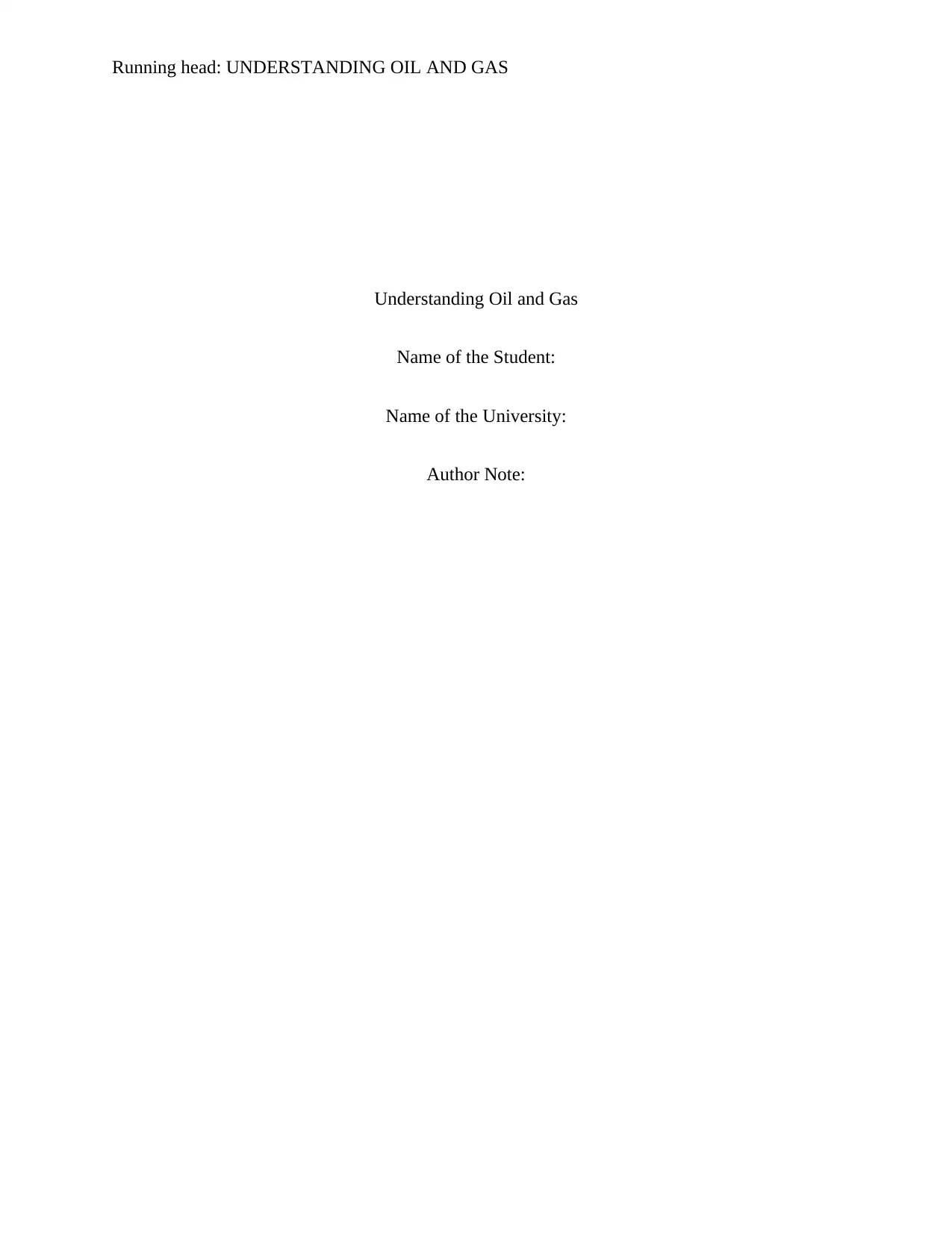
Running head: UNDERSTANDING OIL AND GAS
Understanding Oil and Gas
Name of the Student:
Name of the University:
Author Note:
Understanding Oil and Gas
Name of the Student:
Name of the University:
Author Note:
Secure Best Marks with AI Grader
Need help grading? Try our AI Grader for instant feedback on your assignments.
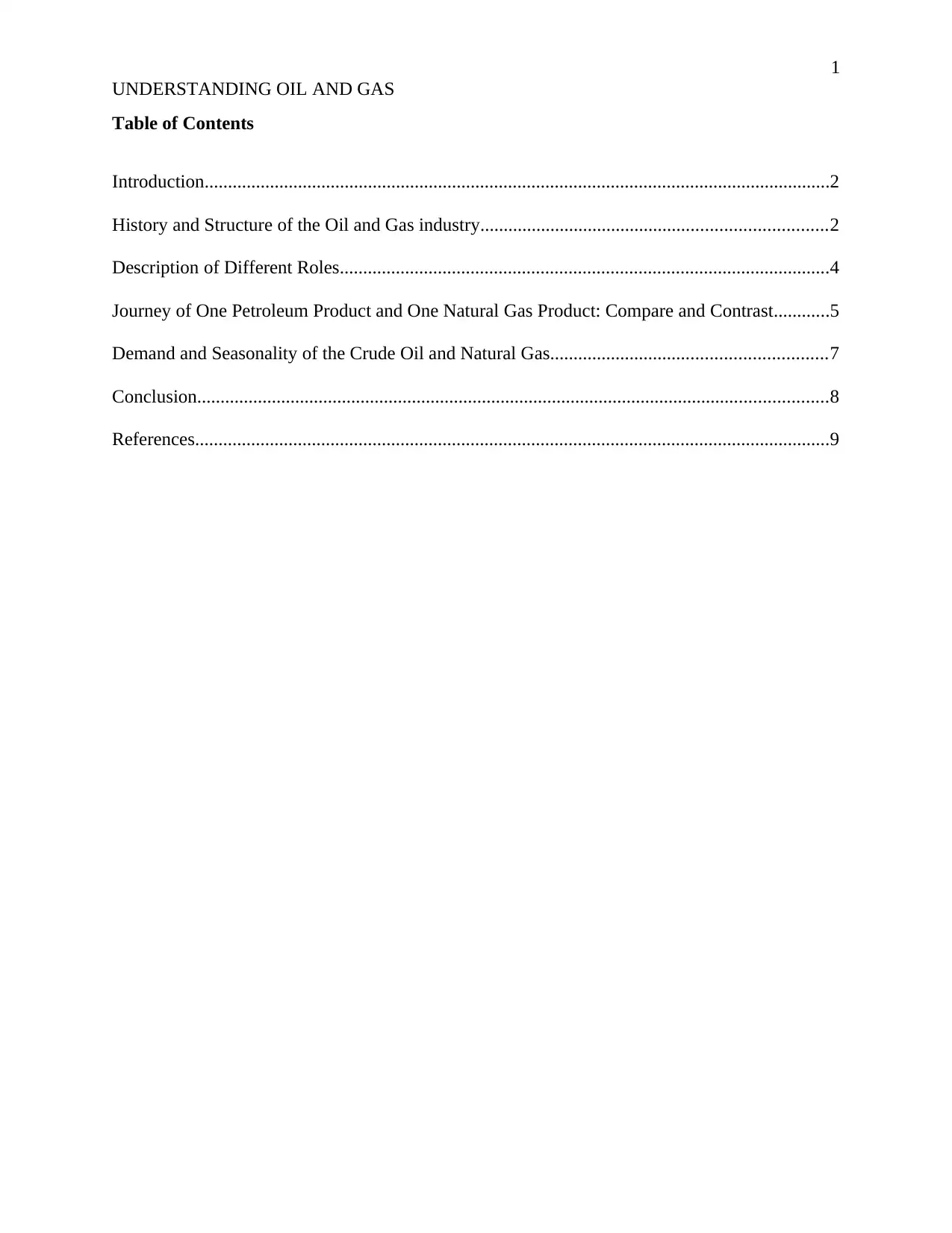
1
UNDERSTANDING OIL AND GAS
Table of Contents
Introduction......................................................................................................................................2
History and Structure of the Oil and Gas industry..........................................................................2
Description of Different Roles.........................................................................................................4
Journey of One Petroleum Product and One Natural Gas Product: Compare and Contrast............5
Demand and Seasonality of the Crude Oil and Natural Gas...........................................................7
Conclusion.......................................................................................................................................8
References........................................................................................................................................9
UNDERSTANDING OIL AND GAS
Table of Contents
Introduction......................................................................................................................................2
History and Structure of the Oil and Gas industry..........................................................................2
Description of Different Roles.........................................................................................................4
Journey of One Petroleum Product and One Natural Gas Product: Compare and Contrast............5
Demand and Seasonality of the Crude Oil and Natural Gas...........................................................7
Conclusion.......................................................................................................................................8
References........................................................................................................................................9
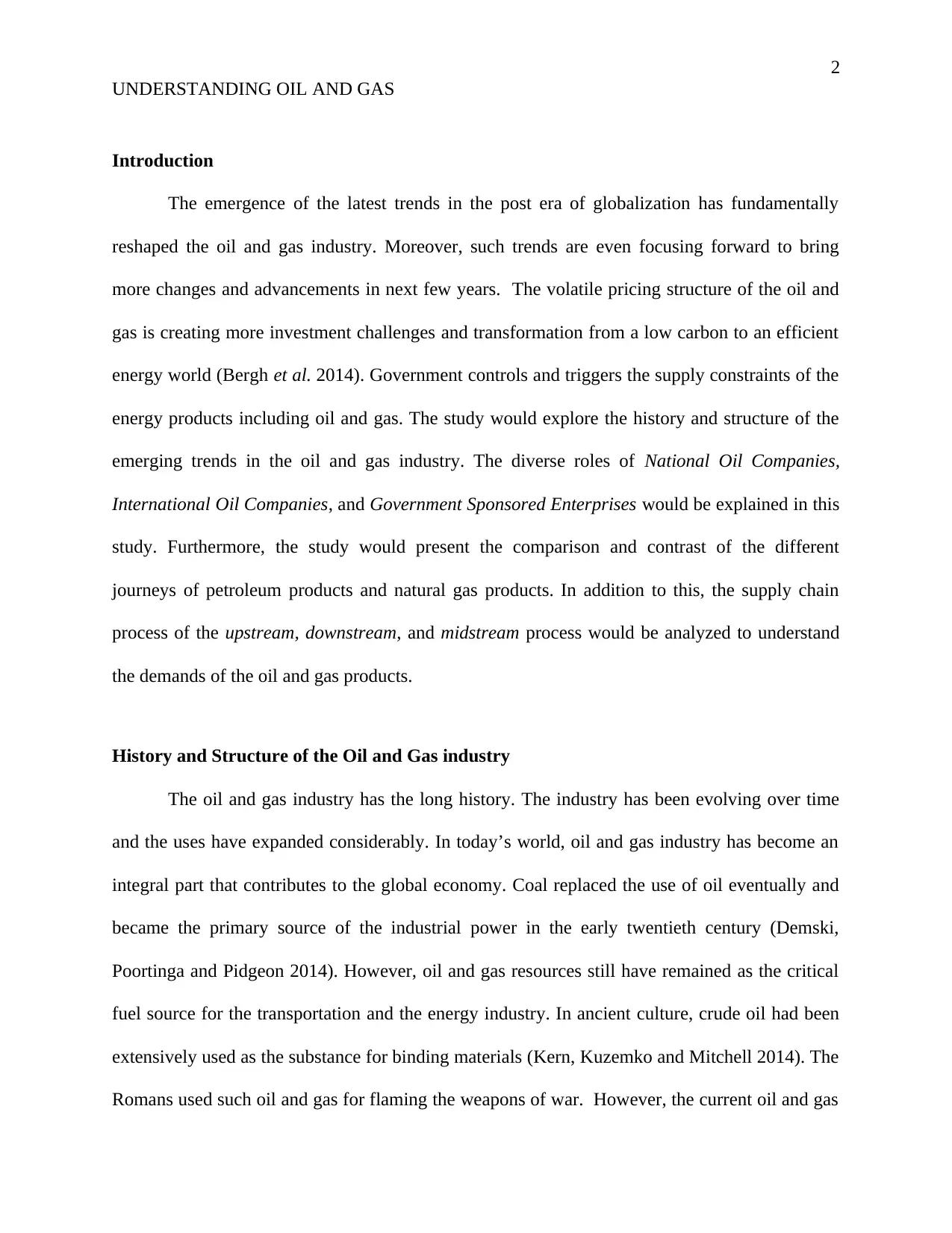
2
UNDERSTANDING OIL AND GAS
Introduction
The emergence of the latest trends in the post era of globalization has fundamentally
reshaped the oil and gas industry. Moreover, such trends are even focusing forward to bring
more changes and advancements in next few years. The volatile pricing structure of the oil and
gas is creating more investment challenges and transformation from a low carbon to an efficient
energy world (Bergh et al. 2014). Government controls and triggers the supply constraints of the
energy products including oil and gas. The study would explore the history and structure of the
emerging trends in the oil and gas industry. The diverse roles of National Oil Companies,
International Oil Companies, and Government Sponsored Enterprises would be explained in this
study. Furthermore, the study would present the comparison and contrast of the different
journeys of petroleum products and natural gas products. In addition to this, the supply chain
process of the upstream, downstream, and midstream process would be analyzed to understand
the demands of the oil and gas products.
History and Structure of the Oil and Gas industry
The oil and gas industry has the long history. The industry has been evolving over time
and the uses have expanded considerably. In today’s world, oil and gas industry has become an
integral part that contributes to the global economy. Coal replaced the use of oil eventually and
became the primary source of the industrial power in the early twentieth century (Demski,
Poortinga and Pidgeon 2014). However, oil and gas resources still have remained as the critical
fuel source for the transportation and the energy industry. In ancient culture, crude oil had been
extensively used as the substance for binding materials (Kern, Kuzemko and Mitchell 2014). The
Romans used such oil and gas for flaming the weapons of war. However, the current oil and gas
UNDERSTANDING OIL AND GAS
Introduction
The emergence of the latest trends in the post era of globalization has fundamentally
reshaped the oil and gas industry. Moreover, such trends are even focusing forward to bring
more changes and advancements in next few years. The volatile pricing structure of the oil and
gas is creating more investment challenges and transformation from a low carbon to an efficient
energy world (Bergh et al. 2014). Government controls and triggers the supply constraints of the
energy products including oil and gas. The study would explore the history and structure of the
emerging trends in the oil and gas industry. The diverse roles of National Oil Companies,
International Oil Companies, and Government Sponsored Enterprises would be explained in this
study. Furthermore, the study would present the comparison and contrast of the different
journeys of petroleum products and natural gas products. In addition to this, the supply chain
process of the upstream, downstream, and midstream process would be analyzed to understand
the demands of the oil and gas products.
History and Structure of the Oil and Gas industry
The oil and gas industry has the long history. The industry has been evolving over time
and the uses have expanded considerably. In today’s world, oil and gas industry has become an
integral part that contributes to the global economy. Coal replaced the use of oil eventually and
became the primary source of the industrial power in the early twentieth century (Demski,
Poortinga and Pidgeon 2014). However, oil and gas resources still have remained as the critical
fuel source for the transportation and the energy industry. In ancient culture, crude oil had been
extensively used as the substance for binding materials (Kern, Kuzemko and Mitchell 2014). The
Romans used such oil and gas for flaming the weapons of war. However, the current oil and gas
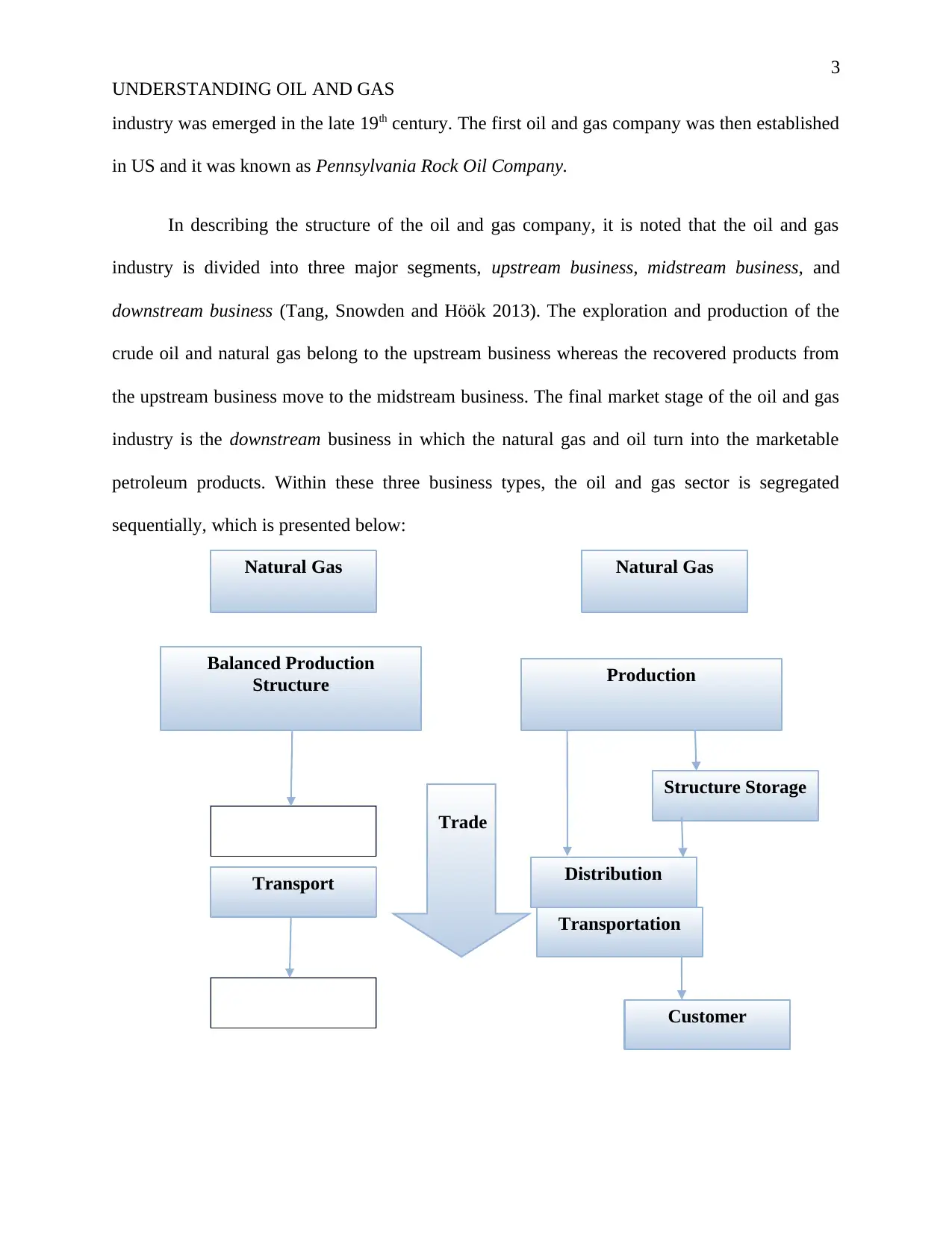
Natural Gas Natural Gas
Balanced Production
Structure Production
Transport
Distribution
Customer
Structure Storage
Distribution
Transportation
Customer
Trade
3
UNDERSTANDING OIL AND GAS
industry was emerged in the late 19th century. The first oil and gas company was then established
in US and it was known as Pennsylvania Rock Oil Company.
In describing the structure of the oil and gas company, it is noted that the oil and gas
industry is divided into three major segments, upstream business, midstream business, and
downstream business (Tang, Snowden and Höök 2013). The exploration and production of the
crude oil and natural gas belong to the upstream business whereas the recovered products from
the upstream business move to the midstream business. The final market stage of the oil and gas
industry is the downstream business in which the natural gas and oil turn into the marketable
petroleum products. Within these three business types, the oil and gas sector is segregated
sequentially, which is presented below:
Balanced Production
Structure Production
Transport
Distribution
Customer
Structure Storage
Distribution
Transportation
Customer
Trade
3
UNDERSTANDING OIL AND GAS
industry was emerged in the late 19th century. The first oil and gas company was then established
in US and it was known as Pennsylvania Rock Oil Company.
In describing the structure of the oil and gas company, it is noted that the oil and gas
industry is divided into three major segments, upstream business, midstream business, and
downstream business (Tang, Snowden and Höök 2013). The exploration and production of the
crude oil and natural gas belong to the upstream business whereas the recovered products from
the upstream business move to the midstream business. The final market stage of the oil and gas
industry is the downstream business in which the natural gas and oil turn into the marketable
petroleum products. Within these three business types, the oil and gas sector is segregated
sequentially, which is presented below:
Secure Best Marks with AI Grader
Need help grading? Try our AI Grader for instant feedback on your assignments.
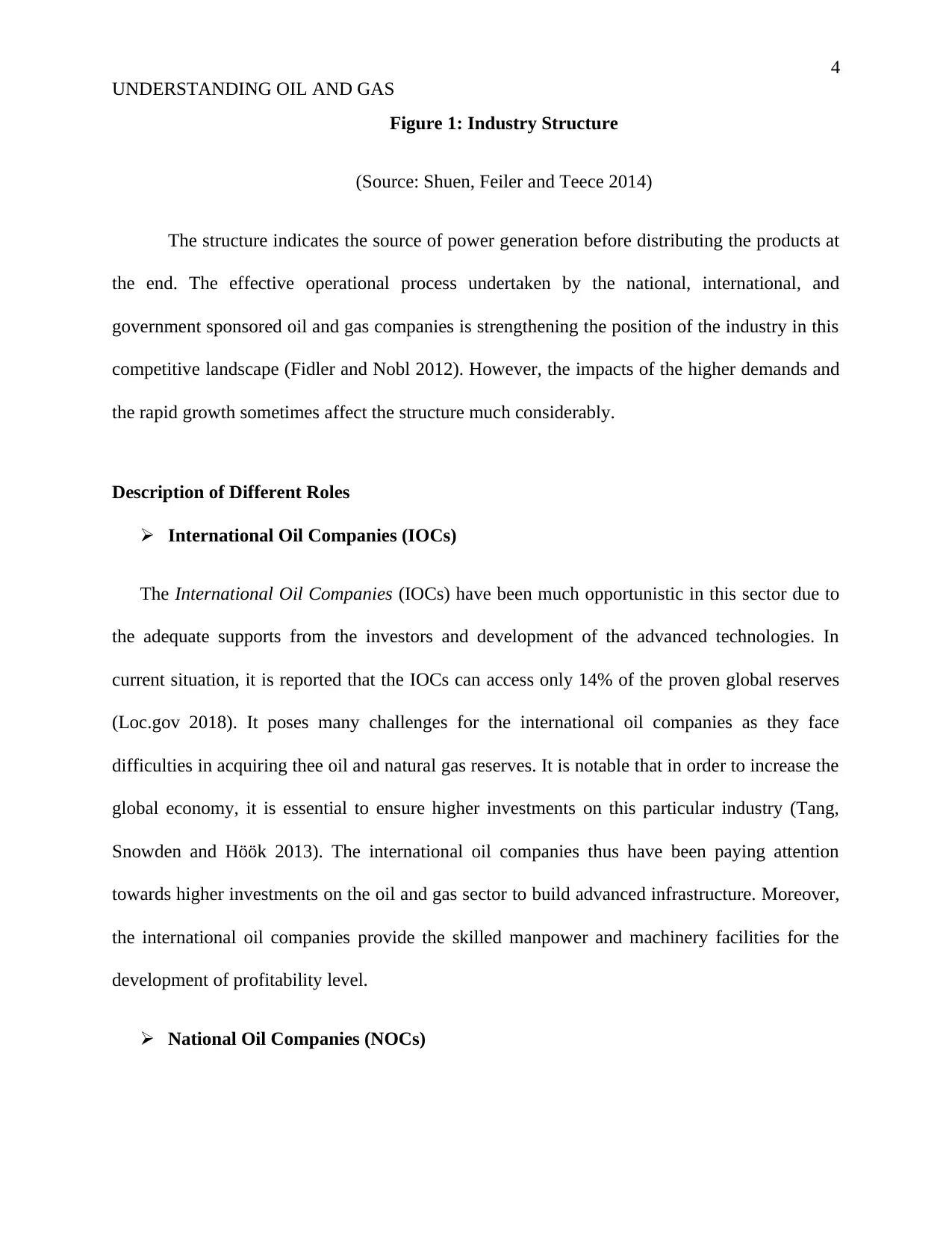
4
UNDERSTANDING OIL AND GAS
Figure 1: Industry Structure
(Source: Shuen, Feiler and Teece 2014)
The structure indicates the source of power generation before distributing the products at
the end. The effective operational process undertaken by the national, international, and
government sponsored oil and gas companies is strengthening the position of the industry in this
competitive landscape (Fidler and Nobl 2012). However, the impacts of the higher demands and
the rapid growth sometimes affect the structure much considerably.
Description of Different Roles
International Oil Companies (IOCs)
The International Oil Companies (IOCs) have been much opportunistic in this sector due to
the adequate supports from the investors and development of the advanced technologies. In
current situation, it is reported that the IOCs can access only 14% of the proven global reserves
(Loc.gov 2018). It poses many challenges for the international oil companies as they face
difficulties in acquiring thee oil and natural gas reserves. It is notable that in order to increase the
global economy, it is essential to ensure higher investments on this particular industry (Tang,
Snowden and Höök 2013). The international oil companies thus have been paying attention
towards higher investments on the oil and gas sector to build advanced infrastructure. Moreover,
the international oil companies provide the skilled manpower and machinery facilities for the
development of profitability level.
National Oil Companies (NOCs)
UNDERSTANDING OIL AND GAS
Figure 1: Industry Structure
(Source: Shuen, Feiler and Teece 2014)
The structure indicates the source of power generation before distributing the products at
the end. The effective operational process undertaken by the national, international, and
government sponsored oil and gas companies is strengthening the position of the industry in this
competitive landscape (Fidler and Nobl 2012). However, the impacts of the higher demands and
the rapid growth sometimes affect the structure much considerably.
Description of Different Roles
International Oil Companies (IOCs)
The International Oil Companies (IOCs) have been much opportunistic in this sector due to
the adequate supports from the investors and development of the advanced technologies. In
current situation, it is reported that the IOCs can access only 14% of the proven global reserves
(Loc.gov 2018). It poses many challenges for the international oil companies as they face
difficulties in acquiring thee oil and natural gas reserves. It is notable that in order to increase the
global economy, it is essential to ensure higher investments on this particular industry (Tang,
Snowden and Höök 2013). The international oil companies thus have been paying attention
towards higher investments on the oil and gas sector to build advanced infrastructure. Moreover,
the international oil companies provide the skilled manpower and machinery facilities for the
development of profitability level.
National Oil Companies (NOCs)
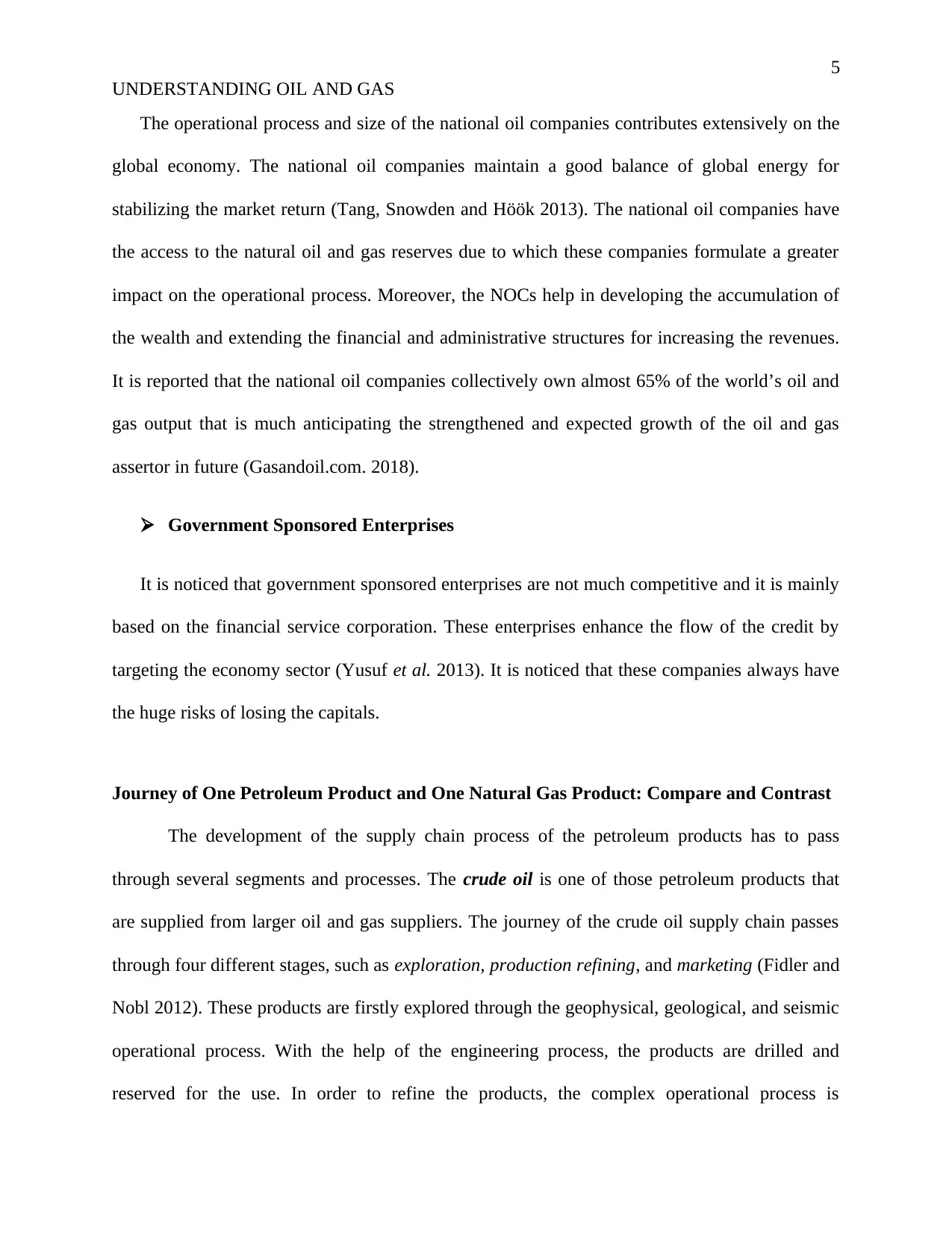
5
UNDERSTANDING OIL AND GAS
The operational process and size of the national oil companies contributes extensively on the
global economy. The national oil companies maintain a good balance of global energy for
stabilizing the market return (Tang, Snowden and Höök 2013). The national oil companies have
the access to the natural oil and gas reserves due to which these companies formulate a greater
impact on the operational process. Moreover, the NOCs help in developing the accumulation of
the wealth and extending the financial and administrative structures for increasing the revenues.
It is reported that the national oil companies collectively own almost 65% of the world’s oil and
gas output that is much anticipating the strengthened and expected growth of the oil and gas
assertor in future (Gasandoil.com. 2018).
Government Sponsored Enterprises
It is noticed that government sponsored enterprises are not much competitive and it is mainly
based on the financial service corporation. These enterprises enhance the flow of the credit by
targeting the economy sector (Yusuf et al. 2013). It is noticed that these companies always have
the huge risks of losing the capitals.
Journey of One Petroleum Product and One Natural Gas Product: Compare and Contrast
The development of the supply chain process of the petroleum products has to pass
through several segments and processes. The crude oil is one of those petroleum products that
are supplied from larger oil and gas suppliers. The journey of the crude oil supply chain passes
through four different stages, such as exploration, production refining, and marketing (Fidler and
Nobl 2012). These products are firstly explored through the geophysical, geological, and seismic
operational process. With the help of the engineering process, the products are drilled and
reserved for the use. In order to refine the products, the complex operational process is
UNDERSTANDING OIL AND GAS
The operational process and size of the national oil companies contributes extensively on the
global economy. The national oil companies maintain a good balance of global energy for
stabilizing the market return (Tang, Snowden and Höök 2013). The national oil companies have
the access to the natural oil and gas reserves due to which these companies formulate a greater
impact on the operational process. Moreover, the NOCs help in developing the accumulation of
the wealth and extending the financial and administrative structures for increasing the revenues.
It is reported that the national oil companies collectively own almost 65% of the world’s oil and
gas output that is much anticipating the strengthened and expected growth of the oil and gas
assertor in future (Gasandoil.com. 2018).
Government Sponsored Enterprises
It is noticed that government sponsored enterprises are not much competitive and it is mainly
based on the financial service corporation. These enterprises enhance the flow of the credit by
targeting the economy sector (Yusuf et al. 2013). It is noticed that these companies always have
the huge risks of losing the capitals.
Journey of One Petroleum Product and One Natural Gas Product: Compare and Contrast
The development of the supply chain process of the petroleum products has to pass
through several segments and processes. The crude oil is one of those petroleum products that
are supplied from larger oil and gas suppliers. The journey of the crude oil supply chain passes
through four different stages, such as exploration, production refining, and marketing (Fidler and
Nobl 2012). These products are firstly explored through the geophysical, geological, and seismic
operational process. With the help of the engineering process, the products are drilled and
reserved for the use. In order to refine the products, the complex operational process is
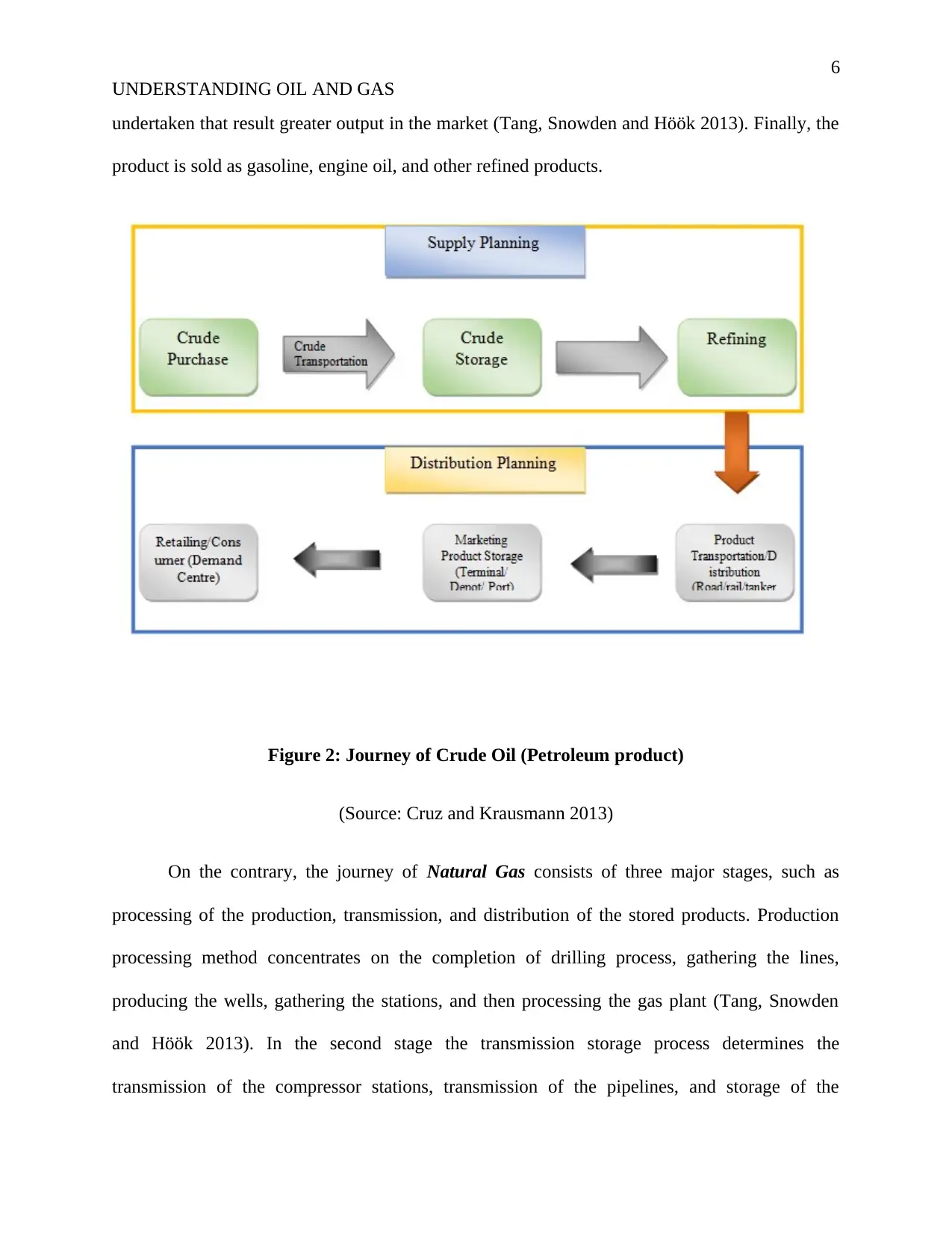
6
UNDERSTANDING OIL AND GAS
undertaken that result greater output in the market (Tang, Snowden and Höök 2013). Finally, the
product is sold as gasoline, engine oil, and other refined products.
Figure 2: Journey of Crude Oil (Petroleum product)
(Source: Cruz and Krausmann 2013)
On the contrary, the journey of Natural Gas consists of three major stages, such as
processing of the production, transmission, and distribution of the stored products. Production
processing method concentrates on the completion of drilling process, gathering the lines,
producing the wells, gathering the stations, and then processing the gas plant (Tang, Snowden
and Höök 2013). In the second stage the transmission storage process determines the
transmission of the compressor stations, transmission of the pipelines, and storage of the
UNDERSTANDING OIL AND GAS
undertaken that result greater output in the market (Tang, Snowden and Höök 2013). Finally, the
product is sold as gasoline, engine oil, and other refined products.
Figure 2: Journey of Crude Oil (Petroleum product)
(Source: Cruz and Krausmann 2013)
On the contrary, the journey of Natural Gas consists of three major stages, such as
processing of the production, transmission, and distribution of the stored products. Production
processing method concentrates on the completion of drilling process, gathering the lines,
producing the wells, gathering the stations, and then processing the gas plant (Tang, Snowden
and Höök 2013). In the second stage the transmission storage process determines the
transmission of the compressor stations, transmission of the pipelines, and storage of the
Paraphrase This Document
Need a fresh take? Get an instant paraphrase of this document with our AI Paraphraser
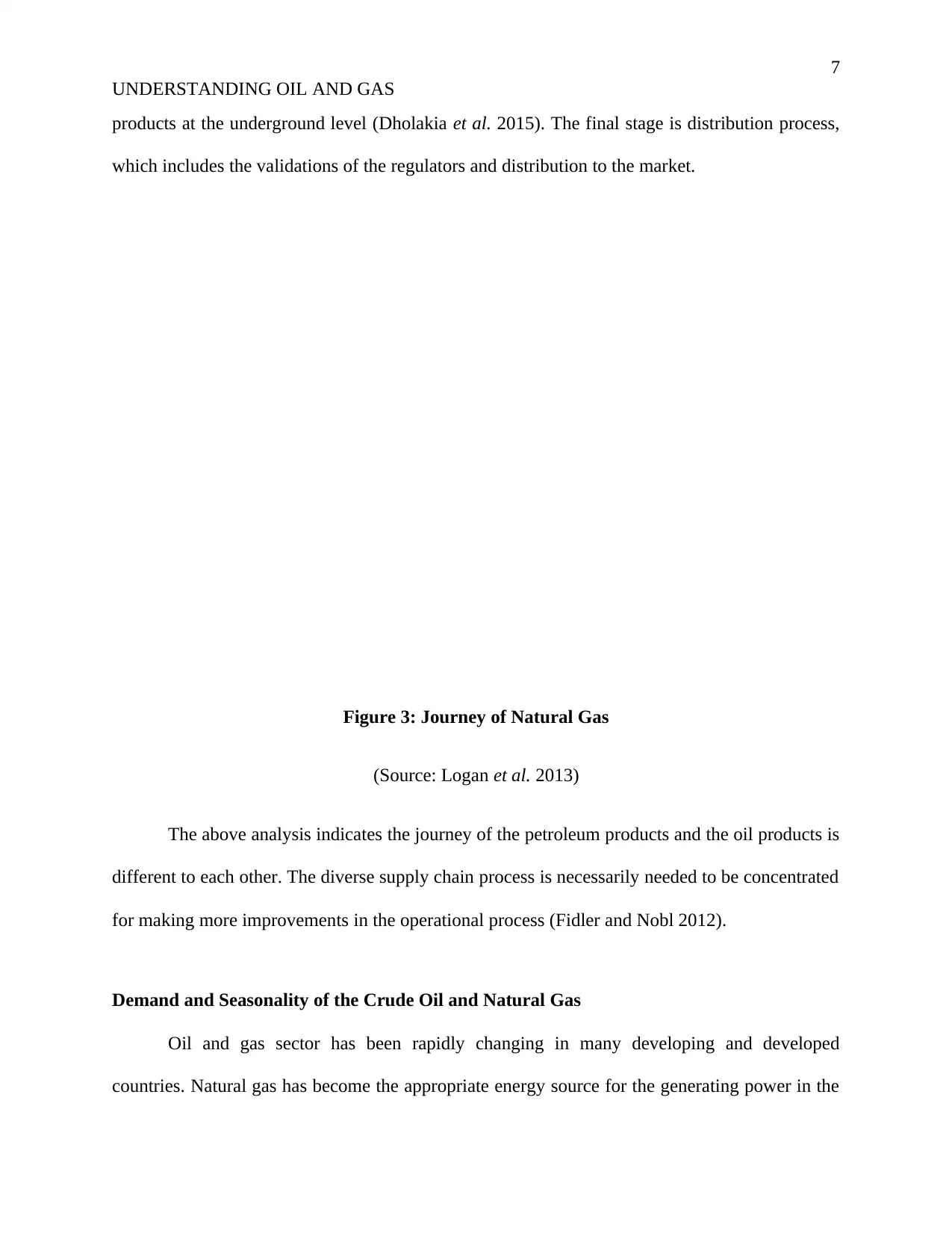
7
UNDERSTANDING OIL AND GAS
products at the underground level (Dholakia et al. 2015). The final stage is distribution process,
which includes the validations of the regulators and distribution to the market.
Figure 3: Journey of Natural Gas
(Source: Logan et al. 2013)
The above analysis indicates the journey of the petroleum products and the oil products is
different to each other. The diverse supply chain process is necessarily needed to be concentrated
for making more improvements in the operational process (Fidler and Nobl 2012).
Demand and Seasonality of the Crude Oil and Natural Gas
Oil and gas sector has been rapidly changing in many developing and developed
countries. Natural gas has become the appropriate energy source for the generating power in the
UNDERSTANDING OIL AND GAS
products at the underground level (Dholakia et al. 2015). The final stage is distribution process,
which includes the validations of the regulators and distribution to the market.
Figure 3: Journey of Natural Gas
(Source: Logan et al. 2013)
The above analysis indicates the journey of the petroleum products and the oil products is
different to each other. The diverse supply chain process is necessarily needed to be concentrated
for making more improvements in the operational process (Fidler and Nobl 2012).
Demand and Seasonality of the Crude Oil and Natural Gas
Oil and gas sector has been rapidly changing in many developing and developed
countries. Natural gas has become the appropriate energy source for the generating power in the
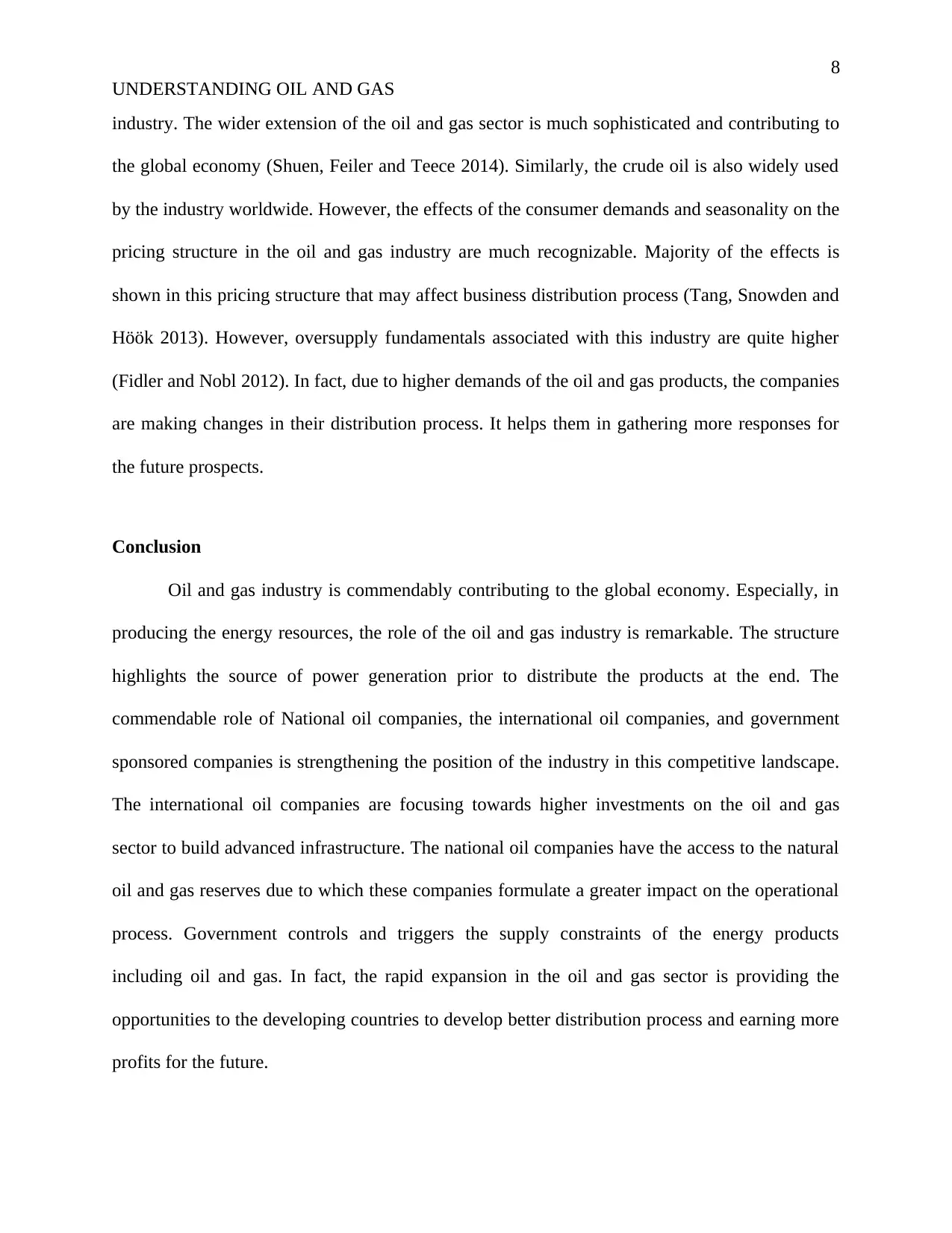
8
UNDERSTANDING OIL AND GAS
industry. The wider extension of the oil and gas sector is much sophisticated and contributing to
the global economy (Shuen, Feiler and Teece 2014). Similarly, the crude oil is also widely used
by the industry worldwide. However, the effects of the consumer demands and seasonality on the
pricing structure in the oil and gas industry are much recognizable. Majority of the effects is
shown in this pricing structure that may affect business distribution process (Tang, Snowden and
Höök 2013). However, oversupply fundamentals associated with this industry are quite higher
(Fidler and Nobl 2012). In fact, due to higher demands of the oil and gas products, the companies
are making changes in their distribution process. It helps them in gathering more responses for
the future prospects.
Conclusion
Oil and gas industry is commendably contributing to the global economy. Especially, in
producing the energy resources, the role of the oil and gas industry is remarkable. The structure
highlights the source of power generation prior to distribute the products at the end. The
commendable role of National oil companies, the international oil companies, and government
sponsored companies is strengthening the position of the industry in this competitive landscape.
The international oil companies are focusing towards higher investments on the oil and gas
sector to build advanced infrastructure. The national oil companies have the access to the natural
oil and gas reserves due to which these companies formulate a greater impact on the operational
process. Government controls and triggers the supply constraints of the energy products
including oil and gas. In fact, the rapid expansion in the oil and gas sector is providing the
opportunities to the developing countries to develop better distribution process and earning more
profits for the future.
UNDERSTANDING OIL AND GAS
industry. The wider extension of the oil and gas sector is much sophisticated and contributing to
the global economy (Shuen, Feiler and Teece 2014). Similarly, the crude oil is also widely used
by the industry worldwide. However, the effects of the consumer demands and seasonality on the
pricing structure in the oil and gas industry are much recognizable. Majority of the effects is
shown in this pricing structure that may affect business distribution process (Tang, Snowden and
Höök 2013). However, oversupply fundamentals associated with this industry are quite higher
(Fidler and Nobl 2012). In fact, due to higher demands of the oil and gas products, the companies
are making changes in their distribution process. It helps them in gathering more responses for
the future prospects.
Conclusion
Oil and gas industry is commendably contributing to the global economy. Especially, in
producing the energy resources, the role of the oil and gas industry is remarkable. The structure
highlights the source of power generation prior to distribute the products at the end. The
commendable role of National oil companies, the international oil companies, and government
sponsored companies is strengthening the position of the industry in this competitive landscape.
The international oil companies are focusing towards higher investments on the oil and gas
sector to build advanced infrastructure. The national oil companies have the access to the natural
oil and gas reserves due to which these companies formulate a greater impact on the operational
process. Government controls and triggers the supply constraints of the energy products
including oil and gas. In fact, the rapid expansion in the oil and gas sector is providing the
opportunities to the developing countries to develop better distribution process and earning more
profits for the future.
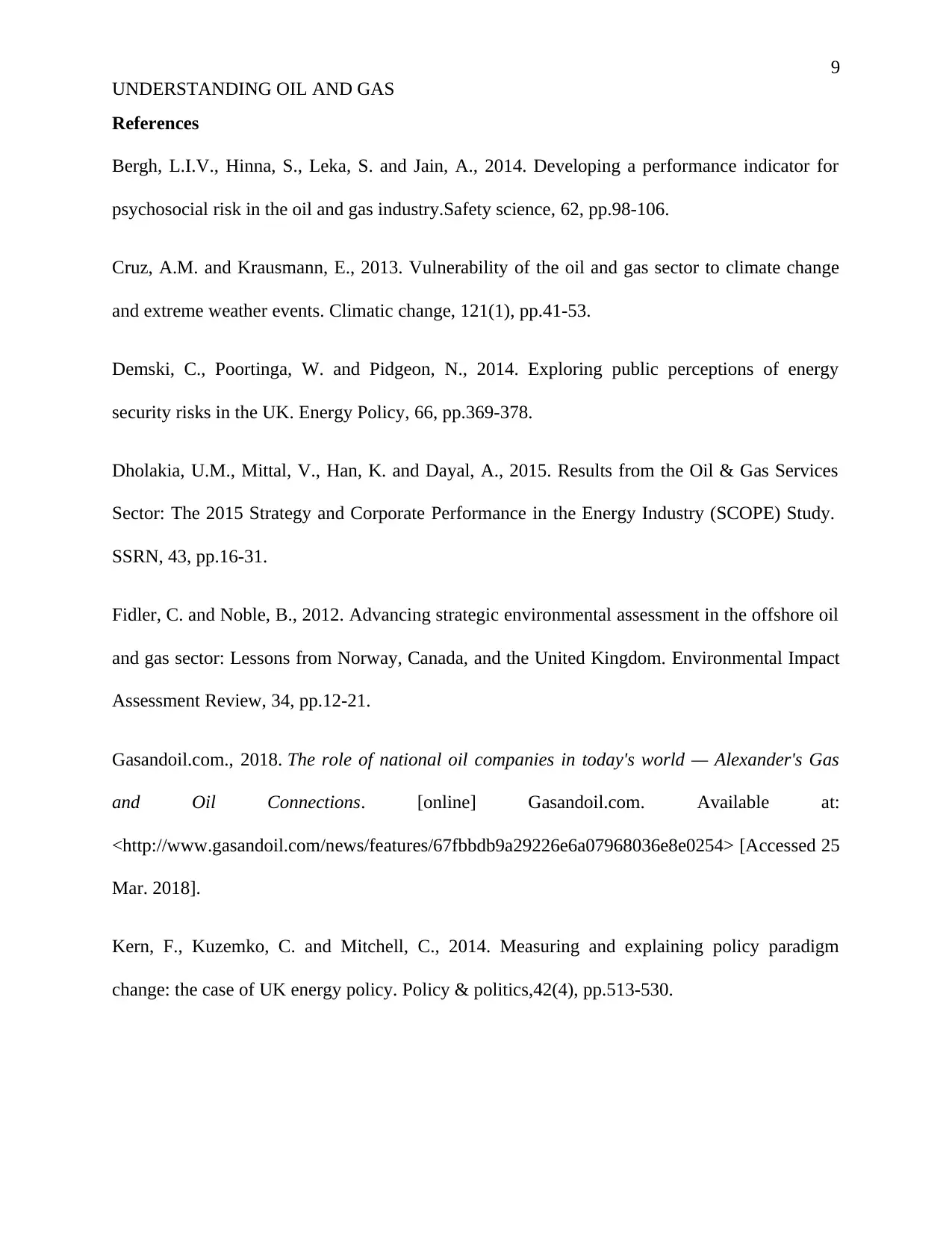
9
UNDERSTANDING OIL AND GAS
References
Bergh, L.I.V., Hinna, S., Leka, S. and Jain, A., 2014. Developing a performance indicator for
psychosocial risk in the oil and gas industry.Safety science, 62, pp.98-106.
Cruz, A.M. and Krausmann, E., 2013. Vulnerability of the oil and gas sector to climate change
and extreme weather events. Climatic change, 121(1), pp.41-53.
Demski, C., Poortinga, W. and Pidgeon, N., 2014. Exploring public perceptions of energy
security risks in the UK. Energy Policy, 66, pp.369-378.
Dholakia, U.M., Mittal, V., Han, K. and Dayal, A., 2015. Results from the Oil & Gas Services
Sector: The 2015 Strategy and Corporate Performance in the Energy Industry (SCOPE) Study.
SSRN, 43, pp.16-31.
Fidler, C. and Noble, B., 2012. Advancing strategic environmental assessment in the offshore oil
and gas sector: Lessons from Norway, Canada, and the United Kingdom. Environmental Impact
Assessment Review, 34, pp.12-21.
Gasandoil.com., 2018. The role of national oil companies in today's world — Alexander's Gas
and Oil Connections. [online] Gasandoil.com. Available at:
<http://www.gasandoil.com/news/features/67fbbdb9a29226e6a07968036e8e0254> [Accessed 25
Mar. 2018].
Kern, F., Kuzemko, C. and Mitchell, C., 2014. Measuring and explaining policy paradigm
change: the case of UK energy policy. Policy & politics,42(4), pp.513-530.
UNDERSTANDING OIL AND GAS
References
Bergh, L.I.V., Hinna, S., Leka, S. and Jain, A., 2014. Developing a performance indicator for
psychosocial risk in the oil and gas industry.Safety science, 62, pp.98-106.
Cruz, A.M. and Krausmann, E., 2013. Vulnerability of the oil and gas sector to climate change
and extreme weather events. Climatic change, 121(1), pp.41-53.
Demski, C., Poortinga, W. and Pidgeon, N., 2014. Exploring public perceptions of energy
security risks in the UK. Energy Policy, 66, pp.369-378.
Dholakia, U.M., Mittal, V., Han, K. and Dayal, A., 2015. Results from the Oil & Gas Services
Sector: The 2015 Strategy and Corporate Performance in the Energy Industry (SCOPE) Study.
SSRN, 43, pp.16-31.
Fidler, C. and Noble, B., 2012. Advancing strategic environmental assessment in the offshore oil
and gas sector: Lessons from Norway, Canada, and the United Kingdom. Environmental Impact
Assessment Review, 34, pp.12-21.
Gasandoil.com., 2018. The role of national oil companies in today's world — Alexander's Gas
and Oil Connections. [online] Gasandoil.com. Available at:
<http://www.gasandoil.com/news/features/67fbbdb9a29226e6a07968036e8e0254> [Accessed 25
Mar. 2018].
Kern, F., Kuzemko, C. and Mitchell, C., 2014. Measuring and explaining policy paradigm
change: the case of UK energy policy. Policy & politics,42(4), pp.513-530.
Secure Best Marks with AI Grader
Need help grading? Try our AI Grader for instant feedback on your assignments.
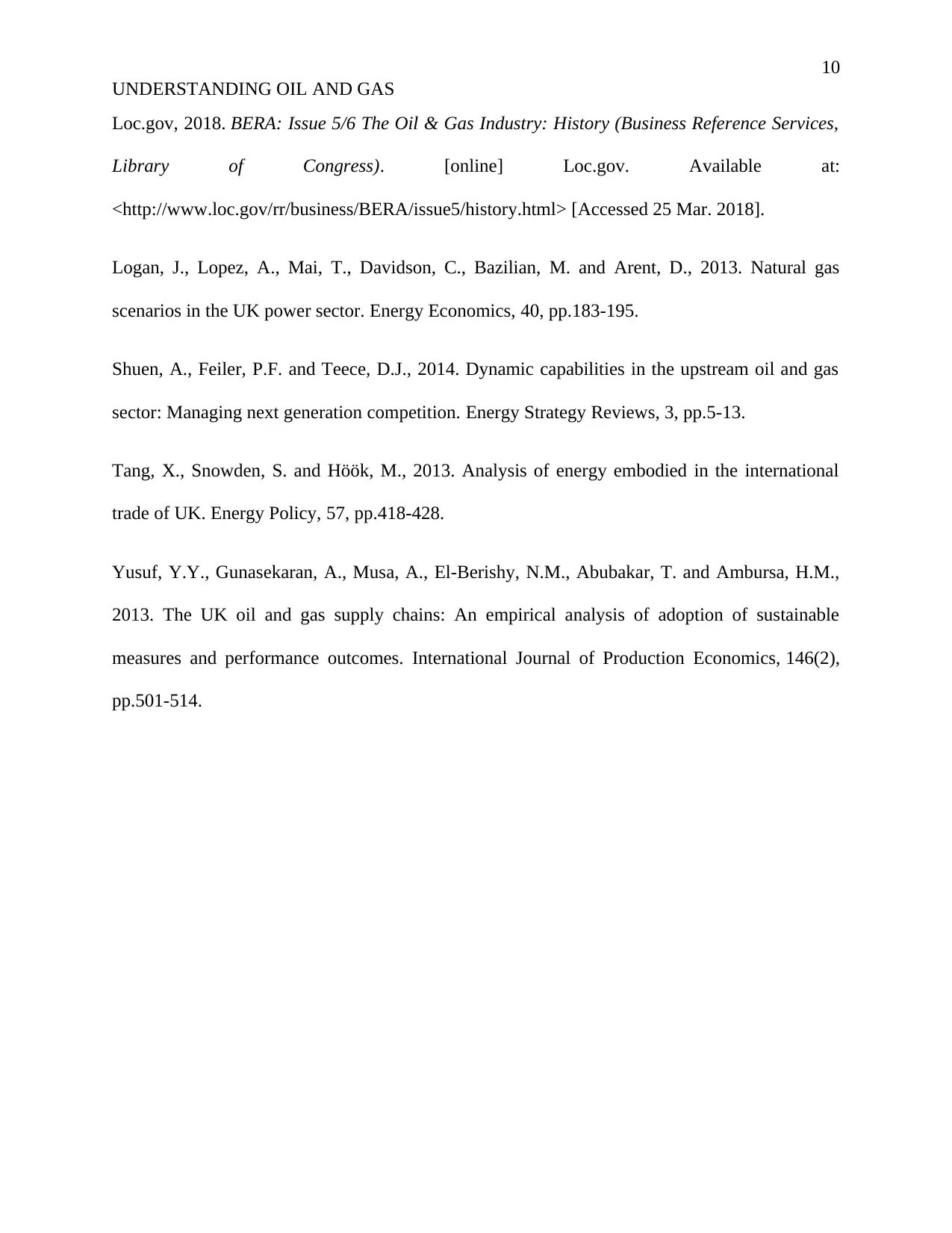
10
UNDERSTANDING OIL AND GAS
Loc.gov, 2018. BERA: Issue 5/6 The Oil & Gas Industry: History (Business Reference Services,
Library of Congress). [online] Loc.gov. Available at:
<http://www.loc.gov/rr/business/BERA/issue5/history.html> [Accessed 25 Mar. 2018].
Logan, J., Lopez, A., Mai, T., Davidson, C., Bazilian, M. and Arent, D., 2013. Natural gas
scenarios in the UK power sector. Energy Economics, 40, pp.183-195.
Shuen, A., Feiler, P.F. and Teece, D.J., 2014. Dynamic capabilities in the upstream oil and gas
sector: Managing next generation competition. Energy Strategy Reviews, 3, pp.5-13.
Tang, X., Snowden, S. and Höök, M., 2013. Analysis of energy embodied in the international
trade of UK. Energy Policy, 57, pp.418-428.
Yusuf, Y.Y., Gunasekaran, A., Musa, A., El-Berishy, N.M., Abubakar, T. and Ambursa, H.M.,
2013. The UK oil and gas supply chains: An empirical analysis of adoption of sustainable
measures and performance outcomes. International Journal of Production Economics, 146(2),
pp.501-514.
UNDERSTANDING OIL AND GAS
Loc.gov, 2018. BERA: Issue 5/6 The Oil & Gas Industry: History (Business Reference Services,
Library of Congress). [online] Loc.gov. Available at:
<http://www.loc.gov/rr/business/BERA/issue5/history.html> [Accessed 25 Mar. 2018].
Logan, J., Lopez, A., Mai, T., Davidson, C., Bazilian, M. and Arent, D., 2013. Natural gas
scenarios in the UK power sector. Energy Economics, 40, pp.183-195.
Shuen, A., Feiler, P.F. and Teece, D.J., 2014. Dynamic capabilities in the upstream oil and gas
sector: Managing next generation competition. Energy Strategy Reviews, 3, pp.5-13.
Tang, X., Snowden, S. and Höök, M., 2013. Analysis of energy embodied in the international
trade of UK. Energy Policy, 57, pp.418-428.
Yusuf, Y.Y., Gunasekaran, A., Musa, A., El-Berishy, N.M., Abubakar, T. and Ambursa, H.M.,
2013. The UK oil and gas supply chains: An empirical analysis of adoption of sustainable
measures and performance outcomes. International Journal of Production Economics, 146(2),
pp.501-514.
1 out of 11
Related Documents
Your All-in-One AI-Powered Toolkit for Academic Success.
+13062052269
info@desklib.com
Available 24*7 on WhatsApp / Email
![[object Object]](/_next/static/media/star-bottom.7253800d.svg)
Unlock your academic potential
© 2024 | Zucol Services PVT LTD | All rights reserved.




